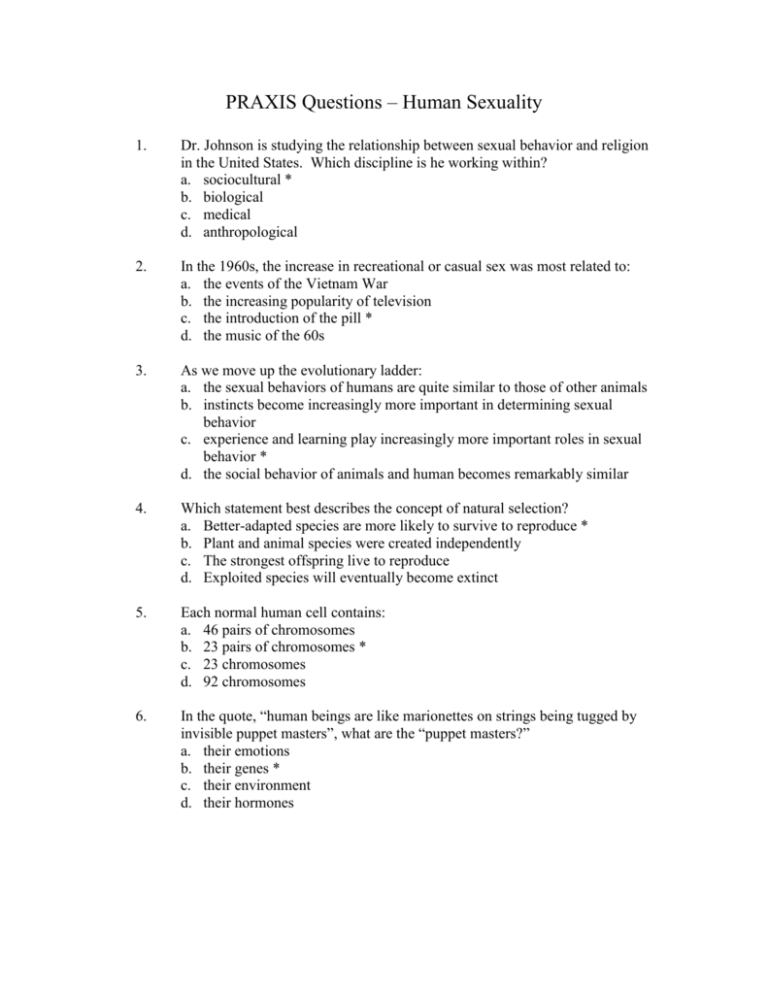
PRAXIS Questions – Human Sexuality
1.
Dr. Johnson is studying the relationship between sexual behavior and religion
in the United States. Which discipline is he working within?
a. sociocultural *
b. biological
c. medical
d. anthropological
2.
In the 1960s, the increase in recreational or casual sex was most related to:
a. the events of the Vietnam War
b. the increasing popularity of television
c. the introduction of the pill *
d. the music of the 60s
3.
As we move up the evolutionary ladder:
a. the sexual behaviors of humans are quite similar to those of other animals
b. instincts become increasingly more important in determining sexual
behavior
c. experience and learning play increasingly more important roles in sexual
behavior *
d. the social behavior of animals and human becomes remarkably similar
4.
Which statement best describes the concept of natural selection?
a. Better-adapted species are more likely to survive to reproduce *
b. Plant and animal species were created independently
c. The strongest offspring live to reproduce
d. Exploited species will eventually become extinct
5.
Each normal human cell contains:
a. 46 pairs of chromosomes
b. 23 pairs of chromosomes *
c. 23 chromosomes
d. 92 chromosomes
6.
In the quote, “human beings are like marionettes on strings being tugged by
invisible puppet masters”, what are the “puppet masters?”
a. their emotions
b. their genes *
c. their environment
d. their hormones
7.
It can be said that all societies:
a. believe that biology is destiny
b. have similar moral codes regulating sexual behavior
c. are more common than different in their sexual practices
d. regulate sexual behavior in some fashion *
8.
According to behavioral theory, sexual dysfunctions in adulthood result from:
a. repression of sexual feelings
b. fixation in one of the psychosexual stages of development
c. learned associations between sexual stimulation and feelings of anxiety *
d. observational learning
9.
In studying human sexuality, which statement is true?
a. Human sexuality is a complex interaction between biological,
sociocultural, and psychological factors. *
b. Human sexuality is largely driven by biology and secondarily driven by
culture.
c. Cultural values and beliefs determine what is normal, natural, and moral in
sexual behavior.
d. There are many universal patterns of sexual behavior and universal beliefs
about the morality of sexual behaviors.
10.
Which of the following statements is true?
a. the natural course of embryonic development is male
b. the absence of a Y chromosome alters the developmental course from
male to female
c. the presence of only one X chromosome, instead of two, will result in a
male fetus
d. the presence of a Y chromosome alters the developmental course from
female to male *
11.
Gender identity is defined as :
a. the roles or behaviors we personally identify with our sex
b. an individual’s self-concept of masculinity or femininity *
c. a culture’s broad expectations of men and women
d. the stereotypical behaviors associated with male or femaleness in a culture
12.
At about what age do children begin to show preferences for gender-typed
activities?
a. 12-18 months
b. 2-3 years *
c. 4-6 years
d. 7-9 years
13.
Males generally exceed females in:
a. verbal problem solving skills
b. visual-spatial abilities *
c. science
d. computational math during elementary school
14.
Gender differences in intellectual abilities are best explained by:
a. differences in innate ability
b. differences in temperament
c. differences in development
d. differences in cultural expectations *
15.
Bill is rapidly approaching puberty, as a result, what body changes can he
expect?
a. A greater amount of fat will be stored in his hips and thighs.
b. The density of his bones will increase and his pelvis will broaden.
c. He will experience a rapid increase in height, bone density, and muscle. *
d. Testosterone production will lead to an increase in overall body fat.
16.
The average life expectancy of men is seven years less than for females.
Which statement most accurately reflects this difference?
a. Testosterone has more damaging effects on the body.
b. Females are more physically fit than males across the life span.
c. Men are often reluctant to seek health care. *
d. Men tend to place themselves in more physical danger than women.
17.
Games like “playing doctor”, or activities like “show me yours”, become most
common between the ages of:
a. 2 and 3
b. 3 and 4
c. 5 and 6
d. 6 and 10 *
18.
From the mid-1800s to today, the average age of menarche has changed from:
a. age 11 to age 13
b. age 13 to age 16
c. age 17 to age 13 *
d. age 18 to age 10
19.
Among teenage girls who become pregnant, how many will become pregnant
again within a year?
a. one in thirty
b. one in ten
c. one in five *
d. one in three
20.
When comprehensive sex education is combined with condom distribution
and counseling about sex:
a. the teenage pregnancy rate drops 50%
b. the pregnancy rated drops by 75% and the spread of STIs by 59%
c. the pregnancy rate remains the same *
d. the pregnancy rate drops by 25%








